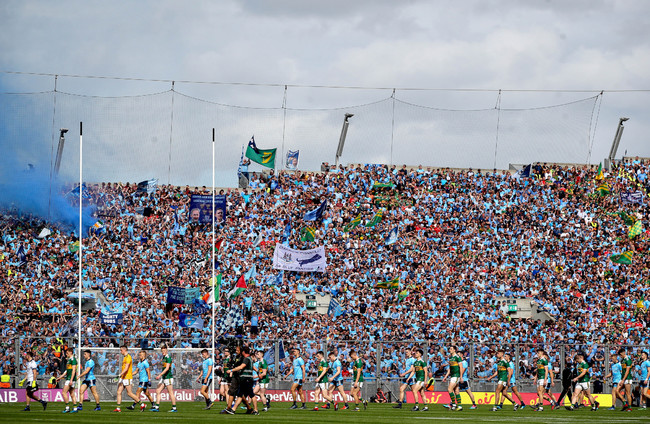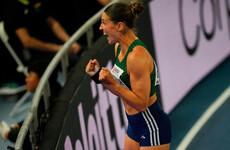THE KERRY AND Dublin rivalry is not, as you might think, an ancient battle fought in the times of folklore.
Rather, it was the series of meetings from the 1970s that established it as the chief rivalry in Gaelic football, with all those great contrasts of rural and urban, city and country and so on.
Here, we look at the first five All-Ireland final meetings, that brought us up to 1955.
1892
- Dublin 1-4 Kerry 0-3 – 26 March, 1893
A season that began with some rule changes thought to be necessary at the time, with a goal changed to being worth five points.
While Ulster teams did not enter, only Roscommon entered from Connacht.
The Leinster championship had three teams, Dublin beating Kildare 3-5 to 0-1 in Clonturk, while they then got a walkover in the final against Louth.
In Munster, Kerry beat Cork 3-6 to 0-5 and then Waterford in the final, 1-6 to 0-3.
Dublin met Roscommon in the only semi-final and won 1-9 to 1-1. Of the six games in the entire series, four of them were played at Clonturk Park, Drumcondra.
The final itself was the first time in football when the club teams could include players from anywhere in the county and so it was an extended Laune Rangers of Killorglin panel from Kerry facing Young Irelanders from Dublin.
The hurling final also took place on the same day, same venue, with Cork beating Dublin.
1904
- Kerry 0-5 Dublin 0-2 – 1 July, 1906
Having won their first All-Ireland the year before with victory over London after beating Kildare in the ‘Home’ final, Kerry defended it here with the final played in the Cork Athletic Grounds.
This game being away from the capital also meant one of the first mass-immigration of Dubs fans on the road, which brought all manner of raffish comments in the newspapers about these exotic creatures.
After beating Kilkenny in the Leinster final, Dublin had been for a training camp. They also gained an early advantage when one of the Kerry 17 players sustained an injury and was bundled across to the changing rooms, where he was left in considerable pain until the game finished.
The rivalry was up and running.
1923
- Dublin 1-5 Kerry 1-3
With the Irish Civil War tearing through the county and causing havoc in the day-to-day pursuits of many, this competition began at different stages. The Connacht championship for example started in mid-October, 1923, with Mayo beat Sligo in one semi-final, but the second semi-final between Galway and Mayo wasn’t staged until the following April.
Leinster started in early April and was wrapped up by August, ‘23.
Munster, the region most affected by the fighting, started in July but it wasn’t until October that the final was played.
The All-Ireland final took place in late September, 1924 in Croke Park, with a suspiciously rounded-off attendance of 20,000, and a reported £1,622 taken at the gate.
1924
- Kerry 0-4 Dublin 0-3 – 16 April 1925
‘The game everyone wanted’ after the success of the crowd the year before, this game also was the first for the redeveloped Hogan Stand, replete with a scoreboard.
Con Brosnan’s winning point went a long way in establishing the Kerry football tradition but it also was a setback for Dublin, who would take another 18 seasons before they won their next title.
With the benefit of the new stand, an official record attendance of 28,844 was reported breathlessly, with official trains laid on from Tralee, Killarney, Listowel and Cahirciveen; the legendary ‘Ghost Trains.’ The gate was printed as £2,563, almost £1,000 more than the previous year.
1955
- Kerry 0-12 Dublin 1-6 – 25 September 1955
By now, the GAA was a different world. The chaos and overwhelming work that was required to organise the games had given way to a country at war with other and with each other.
With relative calm, came a short period of stability, before Gaelic games cemented themselves at the centre of diversion and social life, on all local, county, and province-wide levels.
This was Kerry’s 18th All-Ireland and they had burned past Dublin after the Metropolitans equalled their 15 titles in 1942. In fact, this was the end of a period of relative quiet with Dublin as they hadn’t even won a Leinster title since 1942.
Played in front of a then record crowd of 87,102, gate receipts were £10,657, 19 shillings, 6d. One green and gold flag waved enthusiastically in a sea of blue and while on Hill 16.
Six points from Tadgh Lyne – a far-off relation of Adrian and Killian Spillane of the present team – gave Kerry the points required to hold off the Dublin challenge.
********
From 1955, it took 20 years again before they would meet in the final. Dublin were back the following year to beat the Kingdom, 3-8 to 0-10.
Further big days came in ’78 and ’79, with Kerry winning both, as well as the centenary year of 1984 and then 1985.
After that, the rivalry ceased. Dublin were off it for a few years, and Kerry had their own fallow times as Cork came strong. Meath emerged as the big dogs in Leinster for many years. They always seemed to just miss each other along the way.
Right up to 2011, and the All-Ireland final won by Stephen Cluxton’s free into the Hill.
The rivalry was re-awakened, polished down and then souped-up for a new generation. New heroes emerged from the ghosts of John Joe Sheehy and Con Brosnan, Paddy McDonnell and Kevin Heffernan.
Croke Park kept updating, the crowds plateaud. The money kept increasing. The ‘70s brought a cast of names that resound like film stars in Kevin Moran, Tony Hanahoe and Jimmy Keaveney, Pat Spillane, Mickey Sheehy and Horse.
Into the new century; Gooch and James O’Donoghue, up against Diarmuid Connolly, Brian Fenton and – incredibly – Stephen Cluxton still.
Blue and navy against green and gold in the most illustrious All-Ireland final of them all.
How could you get jaded with that?
How could anyone?












Gerards rangers when they win :)